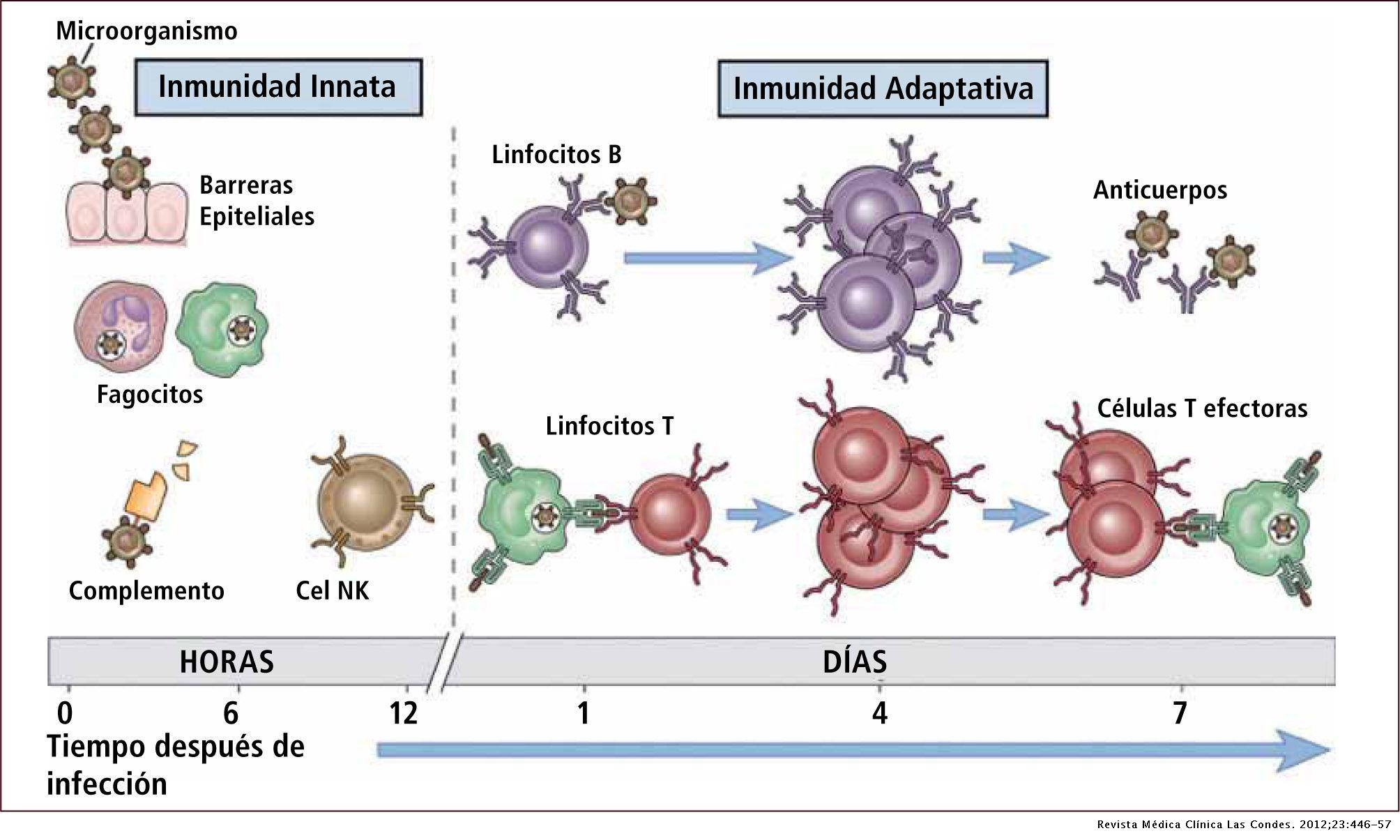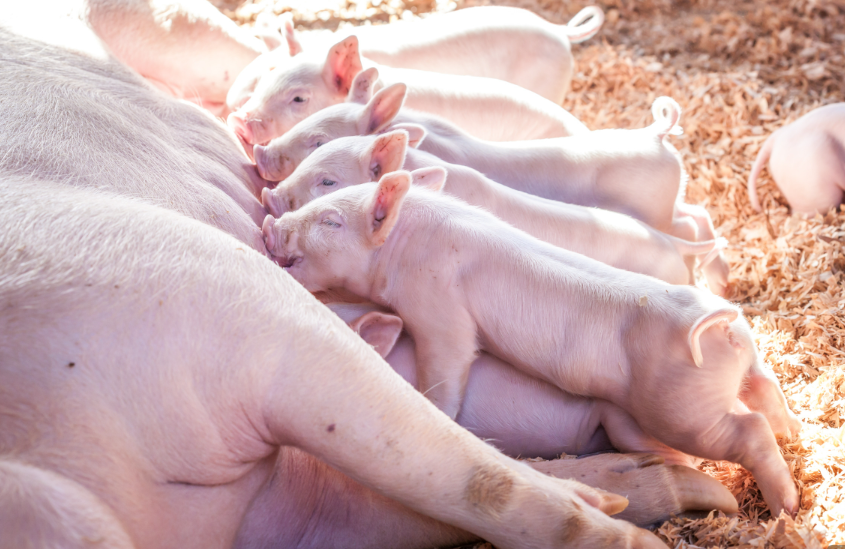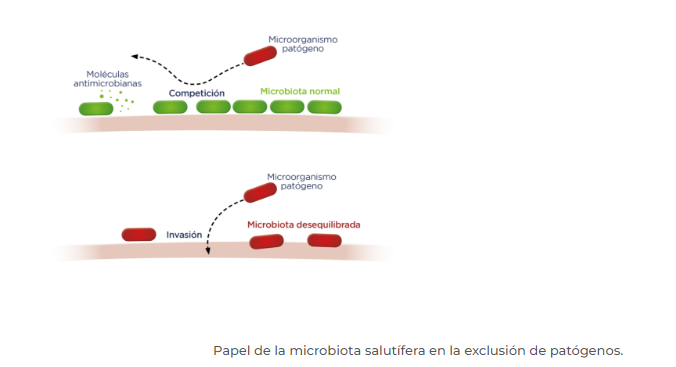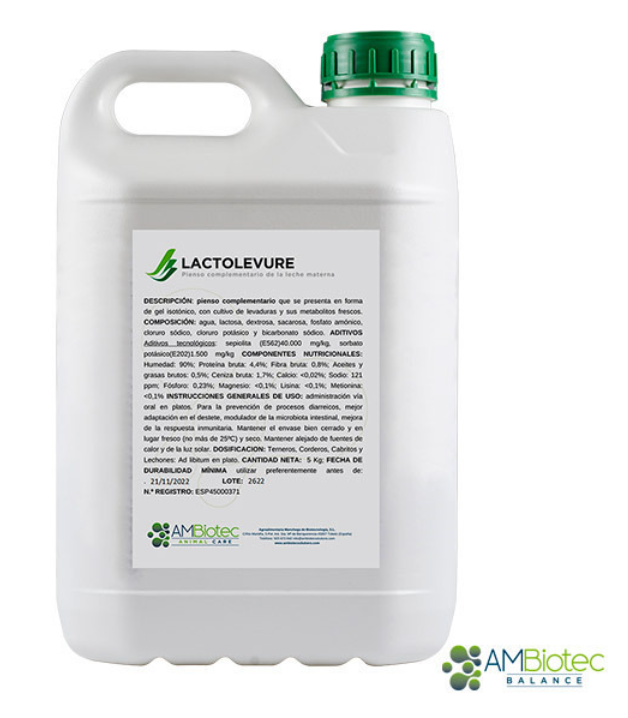- Introduction
- Innate immunity
- Adaptive immunity
- Passive immunity
- Nutrition and immunity
- Role of the microbiota and gastrointestinal tract in immunity.
Contribution of AMBiotec in the development of immunity in the piglet.
Introduction
The immune system is the set of biological elements and processes that allow maintaining the internal balance against external aggressions or aggressions of the organism itself.
All the defense mechanisms that the immune system uses to protect our body are grouped under the term immune response.
When a pig is born, it emerges from the sterile womb into an environment where it is immediately exposed to a wide variety of microorganisms. Its surfaces, such as the gastrointestinal tract, acquire a dense and complex microbiota over time.
Therefore, in order to survive, the newborn animal must be able to control this microbial invasion. In practice, it takes time for the acquired immune system to reach full functionality and innate mechanisms are responsible for the initial resistance to infection.
Thus, newborn piglets are vulnerable to infection during the first weeks of life and need help to protect themselves during this time.

It can be said that the immune system in pigs is divided into three groups or categories:
Nonspecific immune system: it is the first line of defense, which includes physical and chemical barriers, the microbiota and the nonspecific cellular response.
Adaptive immune system: if a pathogen is able to pass through the innate immune system, the next immune barrier is triggered, a specialized barrier characterized by a specific response to a defined antigen.
Passive immune system: this type of immunity is not generated by the animal itself, but is transferred from an external source. In the case of the piglet, the mother transmits her antibodies through colostrum or milk.
Innate immunity
Innate immunity is the first line of defense of the immune system against foreign or harmful substances for the organism. It has no memory so it does not depend on previous exposure to the virus, bacteria or any other pathogen.
It consists primarily of physical and chemical barriers that try to prevent infections in the organism, in addition to the intestinal microbiota, which is fundamental in establishing eubiosis in the intestine:
- Physical barriers: skin, hair, mucosa, mucus, ciliated epithelium, etc.
- Chemical and biochemical barriers: acid pH, lipids, enzymes, proteins, interferons.
Microbiota of the organism: which plays a very important protective role in the animal. The bacteria that form part of the intestinal microbiota compete for habitat and nutrients with other pathogenic bacteria, making it difficult for them to proliferate in the intestine.
If pathogens are able to cross the aforementioned barriers, the non-specific cellular response, also called innate or natural immunity, is triggered.
The innate immune response is rapid and non-specific. It has a series of mechanisms based on the activation of cells located in the tissues, in cytokine production and in an activation of cells of the natural immune system such as macrophages, dendritic cells, Natural-Killer cells (NK cells).
Although the natural response acts as a good protective system, sometimes it is not sufficient and the adaptive immune response has to be activated.
Adaptive immunity
It is a more complex response, specific and very effective for those antigens that have triggered the response.
The acquired immune system is based on two main mechanisms, the control and elimination of invading agents that have been able to overcome the different systems of innate immunity.
These mechanisms are constituted by the response of lymphocytes and the release of antibodies, and 3 strategies can be differentiated:
- CD4 T lymphocytes promote the phagocytic capacity of macrophages.
- The antibodies generated by B lymphocytes bind to the extracellular microorganisms inhibiting their infective capacity and favoring their elimination by phagocytes.
- CD8 or cytotoxic T lymphocytes destroy pathogen-infected cells that remain inaccessible to antibodies.
The adaptive immune system secretes a large number of lymphocytes throughout the maturation process and when they have been stimulated by the presence of antigens, it chooses the most specific cells to fight the pathogen.
The phases of this immune response are carried out in a selective and orderly manner following the same scheme of action:
- Uptake of antigen(s).
- Recognition.
- Lymphocyte activation.
- Elimination
- Containment
- Memory

Passive immunity
This type of immunity is obtained when the animals receive external defenses. It can be natural, when the mother transfers antibodies to the piglet through lactation, or artificial, when the transfer of antibodies comes from a medication or transfusion.
In swine, the development of the immune system begins in gestation with the formation of B cells in the spleen and T cells in the thymus, so it is capable of generating an immune response when antigens are administered via parental or enteric routes.
Lactation
The main source of antibodies for newborn piglets is maternal colostrum, which contains immunoglobulins (IgA, IgG and IgM) and lymphocytes that pass through enterocytes into the bloodstream.
Until weaning, lactogenic immunity is responsible for conferring immunity to the piglet against local microorganisms.
Therefore, it is essential that the sow has an optimal immune system to promote the health of her piglets.

Nutrition and Immunity
Nutrition plays an important role in the proper development of the immune system, as well as in its proper functioning throughout life.
Nutrients are critical to both the development and function of the immune system, and deficiency (either of one or several nutrients) can compromise the state of immunocompetence.
Weaning is a very stressful time for pigs, which can negatively affect both intestinal and immunological levels, altering health, growth and feed intake, especially during the first week after weaning.
That is why feeding and supplementation with complementary feed during the weaning stage is essential to control the stress of the different animals.
A well-nourished animal translates into a healthier animal because it has a greater capacity to respond to infectious agents.
Among the nutrients that are most important in the modulation of the immune response are:
- Proteins such as colostral immunoglobulins.
- Amino acids: especially glutamine, very important for macrophages, enterocytes and cell replication.
- Nucleotides: for lymphocyte proliferation.
- Vitamins A, D, E, E, C and B complex
- Minerals such as iron, copper, and selenium
- Fatty acids such as omega 3 have a regulating effect on inflammatory processes.
- Anti-nutritional factors in raw materials that can cause problems in animals.
- Oxidized fats due to their free radicals that affect the immune response.
Mycotoxins that generate many damages in the animal and weaken its immune system.
Role of the microbiota and gastrointestinal tract in immunity.
Defense mechanisms exist throughout the gastrointestinal tract. On the one hand, saliva is rich in IgA which protects the mouth against infections and the mucosal barrier functions in defense of organic surfaces.
These have substances, such as mucins, which function as a physical barrier preventing pathogenic microorganisms from coming into contact with enterocytes, but also trapping and eliminating them.
On the other hand, there is the intestinal microbiota essential for homeostasis, which is why the immune response to this microbiota in the mucosa must be carefully regulated.
There are a large number of bacteria that live in the gastrointestinal tract. These commensal bacteria invade this niche early after birth and drive the normal development of the immune system. There is more immune activity in the gut than in all other lymphoid tissues.

At birth, the newborn has a complete but relatively immature immune system, reflecting the immaturity of the mediators and effectors of the immune response.
In this maturation process, commensal microorganisms play a key role, they constitute one of the first immunogenic stimuli that the neonate faces and their recognition is carried out by receptors present in the cells of the non-specific immune system, mainly dendritic cells and macrophages that recognize molecular patterns associated with pathogens, expressed by bacteria, viruses and fungi that make up the microbiota.
This is why early exposure to an adequate microbial flora leads to the expansion and development of an efficient immune system.
Contribution of AMBiotec in the development of immunity in the piglet.
AMBiotec, hand in hand with the development of new technologies and animal welfare, launches LACTOLEVURE, an exclusive postbiotic, which provides inanimate yeasts together with their fresh metabolites derived from their multiplication such as enzymes, VFA, vitamins and amino acids.
Its benefits include diverse effects such as modification of nutrient digestibility, development of the digestive mucosa, reduction of digestive colonization by pathogenic bacteria such as Salmonella and development of the immune response.
LACTOLEVURE has active components that stimulate the cells of the endothelial system and produce an increase in resistance to infections.
It intervenes in the stimulation of innate immunity, at the level of monocytes and macrophages, cells that present receptors for β-glucans and that when stimulated induce the production of TNF-α, IL-1, platelet activating factor, leading to a state of development of the immune system.
It also acts by inhibiting the local and systemic inflammatory response by regulating the increase of cytokines and chemokines that activate T cells and B cells.
This translates into an improved intestinal system as well as increased nutrient absorption and therefore better yields on farms using LACTOLEVURE.

Why Lactolevure?
- The immune system is fundamental to the life of the pig. Immune responses are slow to develop and newborns obtain their immunoglobulins from the dam. Early weaning, low milk intake and other stressful stimuli in the piglet delay the development of the immune system and expose the animal.
The incorporation of Lactolevure in the diet of pre- and post-weaning piglets generates a beneficial effect, reducing health problems, modulating the microbiota and stimulating the development of the immune system, resulting in improvements in animal welfare and farm productivity.





